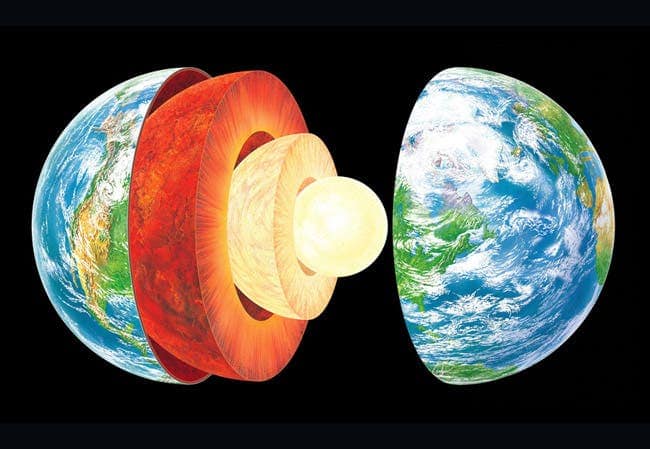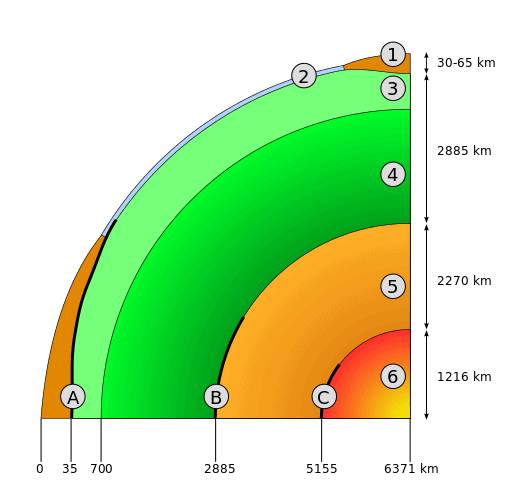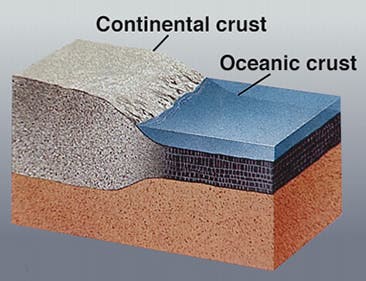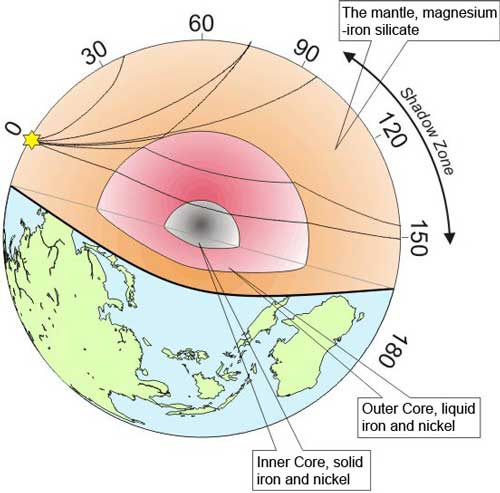Which Layer Is Earth's Thinnest
The Earth can be divided into four primary layers: the solid chaff on the outside, the mantle, the outer core and the inner core. Out of them, the crust is the thinnest layer of the Earth, amounting for less than one% of our planet's volume.
The Globe'south structure

The World's structure can be classified in ii means – based on mechanical backdrop, and based on the chemical science. Here, we're just going to discuss a basic classification, without going into most details. The principal focus here is to empathise how the Globe's crust actually is, and why it is the thinnest layer.
- The crust ranges from 5–seventy km (~3–44 miles) in depth and is the outermost layer. The thinnest parts are oceanic crust, while the thicker parts are continental crust. Most rocks at the Earth's surface are relatively young (less than 100 one thousand thousand years old, compared to the Earth's age, which is approximately iv,4 billion years), but since we found some rocks which are much older, nosotros know that World has had a solid crust for at least 4.4 billion years.
- The curtainextends from where the crust ends to about 2,890 km, making it the thickest layer of Earth. The mantle is likewise composed of silicate rocks, but the mantle as a whole is very viscous – the loftier temperatures there cause the silicate material to be sufficiently ductile that it tin can period (in a very long time). The mantle is generally divided into the upper and the lower drape.
- The core, typically divided into theouter cadre and theinner core. The outer core is regarded as viscous, though much less so than the pall, while the inner cadre is solid.

The Globe's chaff
Our planet'southward chaff is on boilerplate nearly xl km deep – which is much thinner than the mantle, the outer core and the inner core – you tin think of it like the peel of an apple. The crust hither has been generated through igneous processes, which explains why the chaff has much more incompatible elements than the mantle.

At the bottom of the oceans and some seas, there is oceanic crust. Oceanic crust is very thin (usually under x km), and is composed of dumbo, typically dark (mafic) rocks: basalt, gabbro, diabase. The continental crust is thicker than that – commonly it's effectually 40 km deep, only can go up to 70. The two types of crust are also sometimes called granitic (continental) and basaltic (oceanic).
The crust is not one rigid layer, but is cleaved into xv tectonic plates, all in relative movement one to the other. This is called global tectonics. The plates themselves are thicker than the chaff alone, and likewise consist of the shallow mantle beneath the crust – this together is chosen the litosphere. The crust is where rocks interact with the hydrosphere and more than chiefly, the atmosphere. New rocks, minerals and materials are formed hither. Here's the of import part: all of the multifariousness and phenomena that nosotros tin see with our own eyes take place in the crust. Everything, from mining ores to oil to forming mountains to thick deposits, faults and whatsoever you e'er heard about geologists observing directly takes place inside the crust (or at the very surface). The deepest drill always is just over 12 km, and nosotros won't be seeing the bottom of the crust with our own eyes for a very long time.
How nosotros know
OK, so there's a chaff, information technology'due south thin, there's also a mantle and a core… but if we can't go there, how do we know?
That's a very good question – but this is where science comes in. We know all of this (and we know it with a very high degree of conviction) through indirect observation.

A century ago, people didn't know the Earth had a chaff. Some theoretized information technology did, only at that place was very little proof. The first clues came from astronomic indications, but most of what we know today virtually the Earth's structure comes from seismological observations. Seismic waves from big earthquakes pass throughout the Earth, and they conduct with them information from the environments they passed through. Just like rays of light, seismic waves tin reflect, refract and diffract. Considering the speed of the seismic waves depends on density, we can use the travel-time of seismic waves to map alter in density with depth. Too, because some waves only propagate through solid environments, we know that some environments (like the the outer core) are viscous – because the waves don't propagate through them.
In 1909, the brilliant seismologist Andrija Mohorovicic establish that well-nigh l kilometers deep in the Earth there is a sudden change in seismic velocity – and knew that it must be a very meaning discontinuity. He too observed that seismic waves reflect and refract at that depth, which confirmed his ideas. That discontinuity, named today the Mohorovicic aperture (or just "Moho") is regarded today as the limit between the crust and the mantle.
Which Layer Is Earth's Thinnest,
Source: https://www.zmescience.com/science/geology/thinnest-layer-earth/
Posted by: woodhamcamery.blogspot.com


0 Response to "Which Layer Is Earth's Thinnest"
Post a Comment